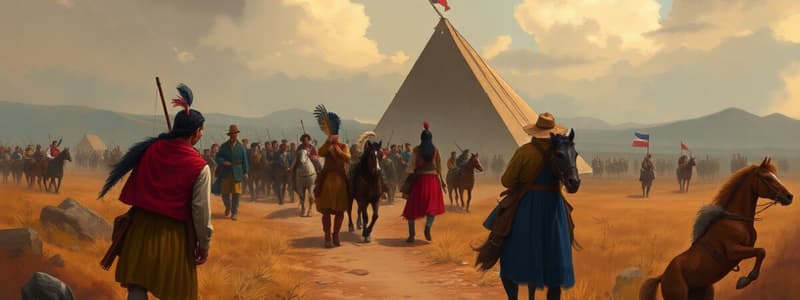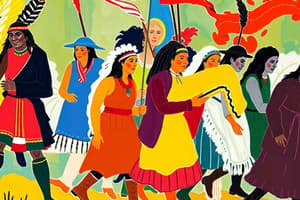Podcast
Questions and Answers
What was the primary goal of the Indian Removal Act passed by the U.S. Congress in 1830?
What was the primary goal of the Indian Removal Act passed by the U.S. Congress in 1830?
- To grant Native American tribes full citizenship and integration into American society.
- To compensate Native American tribes for land voluntarily ceded to the U.S. government.
- To facilitate the relocation of Native American tribes from their ancestral lands to designated territories in the West. (correct)
- To provide military support and protection to Native American tribes against encroaching settlers.
Which of the following factors significantly contributed to the high mortality rate experienced by Native Americans during the Trail of Tears?
Which of the following factors significantly contributed to the high mortality rate experienced by Native Americans during the Trail of Tears?
- The tribes' comprehensive preparations and stockpiling of resources for the journey.
- Adequate access to medical care and sanitation provided by the U.S. government.
- The U.S. army's strict orders to provide food and shelter to all members.
- Exposure to harsh weather, lack of supplies, and outbreaks of disease during the forced march. (correct)
Beyond the immediate suffering and loss of life, what lasting impact did the Trail of Tears have on the affected Native American tribes?
Beyond the immediate suffering and loss of life, what lasting impact did the Trail of Tears have on the affected Native American tribes?
- Preservation of ancestral lands and resources.
- Disruption of social structures, loss of cultural heritage, and economic devastation. (correct)
- Strengthened cultural identities due to shared experiences.
- It fostered trust and improved relations with the U.S. government.
Prior to the forced removal, what strategies did the Cherokee nation employ to resist the U.S. government's policies?
Prior to the forced removal, what strategies did the Cherokee nation employ to resist the U.S. government's policies?
How did President Andrew Jackson justify his support for the Indian Removal Act, despite opposition from some members of Congress and the public?
How did President Andrew Jackson justify his support for the Indian Removal Act, despite opposition from some members of Congress and the public?
Which U.S. military leader was responsible for carrying out the forced removal of the Cherokee people from their lands?
Which U.S. military leader was responsible for carrying out the forced removal of the Cherokee people from their lands?
What specific geographic area were the 'Five Civilized Tribes' forcibly relocated from, according to the Indian Removal Act?
What specific geographic area were the 'Five Civilized Tribes' forcibly relocated from, according to the Indian Removal Act?
Beyond the immediate physical hardships, what long-term psychological impacts might the survivors of the Trail of Tears have experienced?
Beyond the immediate physical hardships, what long-term psychological impacts might the survivors of the Trail of Tears have experienced?
What was the approximate distance that Native Americans were forced to march during the Trail of Tears?
What was the approximate distance that Native Americans were forced to march during the Trail of Tears?
What is the most important lesson that the Trail of Tears teaches us?
What is the most important lesson that the Trail of Tears teaches us?
Flashcards
Trail of Tears
Trail of Tears
A series of forced relocations of Native American nations from their ancestral lands in the United States to areas to the west (primarily present-day Oklahoma).
Indian Removal Act
Indian Removal Act
Enacted in 1830, this law authorized the president to negotiate with Native American tribes for their removal from their lands within existing state borders and relocate them to federal territory west of the Mississippi River.
Andrew Jackson
Andrew Jackson
The 7th President of the United States who supported the Indian Removal Act and pushed for the relocation of Native American tribes.
General Winfield Scott
General Winfield Scott
Signup and view all the flashcards
Five Civilized Tribes
Five Civilized Tribes
Signup and view all the flashcards
Study Notes
- The Trail of Tears refers to a period in history where Native Americans were forcibly removed from their homelands.
- Studying history allows us to learn from past accomplishments and errors.
- The Trail of Tears exemplifies historical injustices against Native Americans due to discriminatory laws.
The Indian Removal Act
- The Cherokee, Muscogee, Chickasaw, Choctaw, and Seminole tribes were forced to march hundreds of miles to reservations located in modern Oklahoma.
- In 1830, Congress passed the Indian Removal Act, which mandated the removal of Native Americans from their native lands.
- Some Native Americans desired to resist but lacked the military strength to oppose the U.S. government.
Cherokee Resistance and Government Response
- The Cherokee initially resisted the removal, leading to President Andrew Jackson's intervention.
- Jackson proposed offering the Cherokee land in Oklahoma and five million dollars in exchange for leaving their native land.
- While some Cherokee accepted the deal, others appealed to Congress for assistance but were denied.
- President Jackson then dispatched General Winfield Scott to forcibly remove the remaining Cherokee.
Forced Removal and the Trail of Tears
- General Winfield Scott and his army compelled the Native Americans to relocate.
- Resistors were incarcerated in stockades.
- Native Americans were compelled to march up to a thousand miles.
- The journey was perilous, leading to many deaths from starvation, disease, and harsh conditions, thus earning the name "Trail of Tears".
- The Trail of Tears provides a historical lesson for treating people fairly and avoiding the mistreatment of others.
Studying That Suits You
Use AI to generate personalized quizzes and flashcards to suit your learning preferences.




